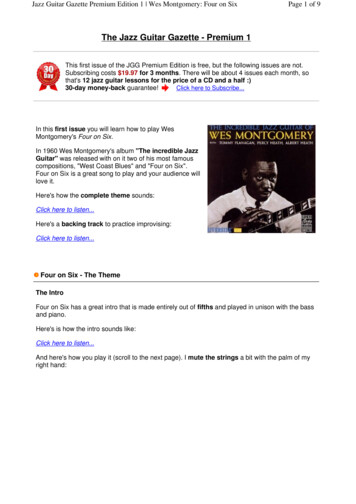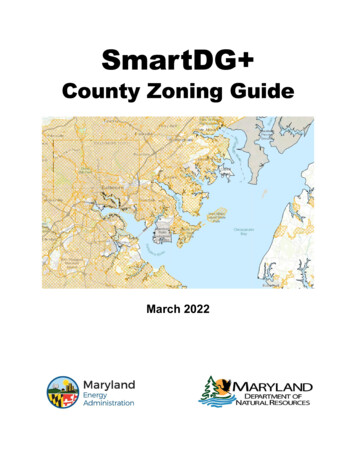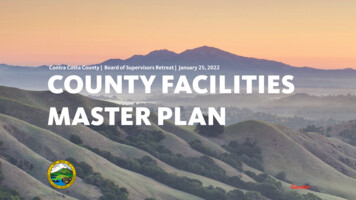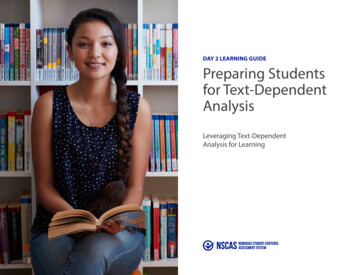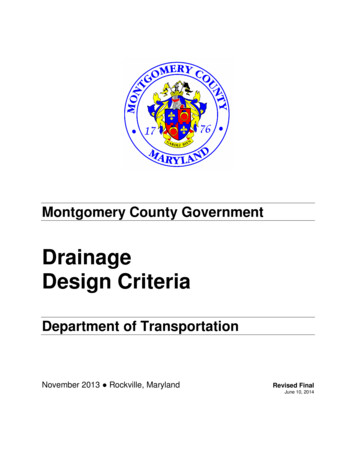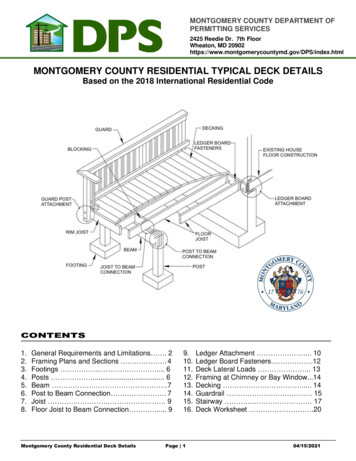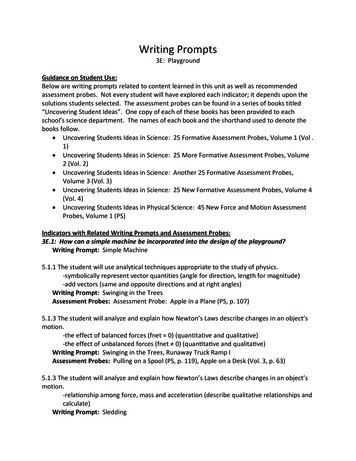
Transcription
Writing Prompts3E: PlaygroundGuidance on Student Use:Below are writing prompts related to content learned in this unit as well as recommendedassessment probes. Not every student will have explored each indicator; it depends upon thesolutions students selected. The assessment probes can be found in a series of books titled“Uncovering Student Ideas”. One copy of each of these books has been provided to eachschool’s science department. The names of each book and the shorthand used to denote thebooks follow. Uncovering Students Ideas in Science: 25 Formative Assessment Probes, Volume 1 (Vol .1) Uncovering Students Ideas in Science: 25 More Formative Assessment Probes, Volume2 (Vol. 2) Uncovering Students Ideas in Science: Another 25 Formative Assessment Probes,Volume 3 (Vol. 3) Uncovering Students Ideas in Science: 25 New Formative Assessment Probes, Volume 4(Vol. 4) Uncovering Students Ideas in Physical Science: 45 New Force and Motion AssessmentProbes, Volume 1 (PS)Indicators with Related Writing Prompts and Assessment Probes:3E.1: How can a simple machine be incorporated into the design of the playground?Writing Prompt: Simple Machine5.1.1 The student will use analytical techniques appropriate to the study of physics.‐symbolically represent vector quantities (angle for direction, length for magnitude)‐add vectors (same and opposite directions and at right angles)Writing Prompt: Swinging in the TreesAssessment Probes: Assessment Probe: Apple in a Plane (PS, p. 107)5.1.3 The student will analyze and explain how Newton’s Laws describe changes in an object’smotion.‐the effect of balanced forces (fnet 0) (quantitative and qualitative)‐the effect of unbalanced forces (fnet 0) (quan ta ve and qualita ve)Writing Prompt: Swinging in the Trees, Runaway Truck Ramp IAssessment Probes: Pulling on a Spool (PS, p. 119), Apple on a Desk (Vol. 3, p. 63)5.1.3 The student will analyze and explain how Newton’s Laws describe changes in an object’smotion.‐relationship among force, mass and acceleration (describe qualitative relationships andcalculate)Writing Prompt: Sledding
Assessment Probes: Lifting Buckets (PS, p. 123)5.1.4 The student will analyze the behavior of forces.‐friction (qualitative description of its nature and behavior)Writing Prompt: Hot BladeAssessment Probes: Just Rolling Along (PS, p. 43), Friction (PS, p. 83), World withoutFriction (PS, p. 87)5.1.4 The student will analyze the behavior of forces.‐relation to work and power (qualitative and quantitative)Writing Prompt: Sledding IAssessment Probes: Bicycle Gears (PS, p. 205)3E.2: How can an interactive educational component be incorporated into the design of theplayground?Writing Prompt: Interactive Educational Component4.1.1 The student will analyze the structure of the atom and describe the characteristics of theparticles found there.‐subatomic particles (protons, neutrons, & electrons –not to include quantummechanical details of electron configurations)‐nucleus & electron cloud (definition; no orbitals included)Writing Prompt: Models of AtomsAssessment Probes:4.3.2 The student will describe observed changes in pressure, volume, or temperature of asample in terms of macroscopic changes and the behavior of particles.‐constant temperature (effect of pressure or volume change to sample of solid, liquid, orgas)‐constant volume (effect of pressure or temperature change to sample of solid, liquid, orgas)‐constant pressure (effect of temperature or volume change to sample of solid, liquid, orgas)Writing Prompt: Scuba DivingAssessment Probes: Assessment Probe: Boiling Time and Temperature (Vol. 2, p. 53)Floating Balloon (Vol. 3, p. 39), Hot and Cold Balloons (Vol. 3, p. 45)5.1.2 The student will use algebraic and geometric concepts to qualitatively and quantitativelydescribe an object’s motion.‐projectile motion (mathematical solutions limited to initial horizontal velocity only;conceptual questions not restricted)Writing Prompt: Pumpkin ChunkinAssessment Probes:
5.2.2 The student will describe the sources and effects of electric and magnetic fields.‐Qualitative description of magnetic field created by moving chargesWriting Prompt: Magnetic MoneyAssessment Probes: Batteries, Bulbs, and Wires (Vol. 3, p. 57), Magnet in Water (Vol. 4, p.67)5.4.3 The student will qualitatively describe the physical behaviors of waves.‐Reflection (apply the law of reflection, represent image formation for plane andconcave surfaces using a ray diagram)‐Refraction (causes and resultant behavior, which may include ray diagrams for behaviorat a plane boundary and for double convex lenses)‐Diffraction (causes and relationship between wavelength and size of opening)‐Interference (constructive and destructive)‐Polarization (relation to type of wave, effect on intensity of light)‐Doppler effect (examples and explanation including frequency shift)Writing Prompt: Highway NoiseAssessment Probes: Mirror on the Wall (Vol. 3, p. 51)3E.3: What surfaces are the most appropriate in the design of the assigned area of theplayground?Writing Prompt: Surface Material4.2.2 The student will explain why organic compounds are so numerous and diverse.‐inorganic and organic compounds (define in terms of carbon content; do not includeCO, CO2, or carbonates as organic compounds; definition of hydrocarbons)‐ability of carbon to form chains and make rings (recognize, but not produce structuralformulas)Writing Prompt: PlasticAssessment Probes:5.1.3 The student will analyze and explain how Newton’s Laws describe changes in an object’smotion.‐action/reaction (application)Writing Prompt: Space Shuttle LaunchAssessment Probes: Finger Strength Contest (PS, p. 127), Equal and Opposite (PS, p. 131)5.3.1 The student will relate thermodynamics to the balance of energy in a system.‐Specific heat (both describe and calculate)Writing Prompt: Pool Party IAssessment Probes:3E.4: How can reused and recycled materials be used in the design of the playground?Writing Prompt: Reused and Recycled Materials
4.1.3 The student will explain how atoms interact with other atoms through the transfer andsharing of electrons in the formation of chemical bonds.‐bond (definition)‐metallic bond (definition)‐metallic, ionic, and molecular substances (melting point)Writing Prompt: Baseball BatsAssessment Probes: Is it Made of Molecules? (Vol. 1, p. 85), Chemical Bonds (Vol. 2, p. 71)4.2.2 The student will explain why organic compounds are so numerous and diverse.‐inorganic and organic compounds (define in terms of carbon content; do not includeCO, CO2, or carbonates as organic compounds; definition of hydrocarbons)‐ability of carbon to form chains and make rings (recognize, but not produce structuralformulas)Writing Prompt: PlasticAssessment Probes:4.2.3 The student will describe the properties of solutions and explain how they form.‐solute, solvent, and solubility‐suspensions and colloidsWriting Prompt: PaintballAssessment Probes: Sugar Wheel (Vol. 4, p. 11)4.3.3 The student will explain why the interactions among particles involve a change in theenergy system.‐endothermic change (bond breaking; dissociation; thermal energy absorbed)Writing Prompt: Recycling EnergyAssessment Probes: Burning Paper (Vol. 4, p. 23), Nails in a Jar (Vol. 4, p. 31), Salt Crystals(Vol. 4, p. 39)
Unit 3E: Playground (3E.1)Simple MachineIndicator(s)5.1.1 The student will use analytical techniques appropriate toThe response should the study of physics.address one of the5.1.3 The student will analyze and explain how Newton’s Lawsindicators.describe changes in an object’s motion.5.1.4 The student will analyze the behavior of forces.5.1.5 The student will analyze systems with regard to theconservation laws.How can a simple machine be incorporated into the design of a playground? In yourreponse, be sure to do the followin: a possible plan for incorporating a simple machine. possible strengths and weaknesses of this plan for incorporating a simplemachine that should be considered. a detailed explanation of how a chemistry or physics concept relates to this planfor incorporating a simple machine. a visual representation (picture, diagram, graph, table, etc.), with labels, tosupport the physics or chemistry concept.Be sure to consider the completeness of your response, supporting details, and accurateuse of terms.
Unit 3E: Playground (3E.1)Swinging in the TreesIndicator(s)5.1.1 The student will use analytical techniques appropriate tothe study of physics.5.1.3 The student will analyze and explain how Newton’s Lawsdescribe changes in an object’s motion.Two monkeys are swinging on vines together. One monkey gets stuck hanging from abranch unable to move. The other monkey, who is very smart, knows that to move heneeds to have a net force in the direction he wants to go.Identify the forces acting on the two monkeys and how those forces impact their abilityto swing. In your reponse, be sure to include: labels of the forces acting on the two monkeys using arrows and appropriateterms. identification of the balanced and unbalanced forces. how unbalanced and balanced forces affect the motion of the monkeys.Be sure to consider the completeness of your response, supporting details, and accurateuse of terms.
Unit 3E: Playground (3E.1)Runaway Truck Ramp IIndicator(s)5.1.3 The student will analyze and explain how Newton’s Lawsdescribe changes in an object’s motion.On roads that go downhill at a steep angle or for a long distance, runaway truck rampsare placed periodically. If the brakes on a truck fail, the truck can pull off on the ramp toslow down. The picture below shows where a truck’s brake failed (point A), where thetruck pulled onto the ramp (point B) and where the truck stopped (point C).CBADescribe the forces that acted on the truck in order to make it stop. In your response,be sure to include: A description of and/or drawing of the forces acting on the truck at all threepoints (A, B and C). Definitions of balanced and unbalanced forces. Identification of whether the forces acting on the truck at each point arebalanced or unbalance. How balanced and unbalanced forces affect motion.Be sure to consider the completeness of your response, supporting details, and accurateuse of terms.
Unit 3E: Playground (3E.1)SleddingIndicator(s)5.1.2 The student will use algebraic and geometric concepts toqualitatively and quantitatively describe an object’s motion.5.1.3 The student will analyze and explain how Newton’s Lawsdescribe changes in an object’s motion.A student comes up with an idea to make some extra money during a snow day. All theneighborhood kids are outside sledding. The student offers to pull the students to thetop of the hill for one dollar per ride. The student notices that it was taking more timeto pull some student to the top then it was other students even though he was pullingwith the same force. He decides to start timing how long it takes to pull each kid andsee if there was a pattern based on their age.Amount of Time vs. Age5040Amount of Timeto Top of Hill 302010078910Age of Sled Ridder1112Explain why some kids too longer to pull to the top of the hill then other kids despitepulling with the same force. In your reponse, be sure to include: the pattern of the data including any exceptions to the trend. the role of Newton’s second law in it taking longer to pull some kids. a prediction of how long it would take to pull the ten and twelve year olds if theywere on the same sled.Be sure to consider the completeness of your response, supporting details, and accurateuse of terms.
Unit 3E: Playground (3E.1)Sledding IIndicator(s)5.1.4 The student will analyze the behavior of forces.A student comes up with an idea to make some extra money during a snow day. All theneighborhood children are outside sledding. He offers to pull the children to the top ofthe 10 meter long hill for one dollar per ride. The student notices that it takes moretime to pull some children to the top then it does for others even though he pulls withthe same force. He decides to start timing how many seconds it takes to pull each kid.When he went home, the student showed his dad a graph he made and says “look athow much work I did pulling children on sleds”.Amount of Time vs. Age5040Amount of Timeto Top of Hill 302010078910Age of Sled Ridder1112Evaluate the student’s statements for scientific accuracy. In your response, be sure toinclude: A definition of work. An explanation of which would take more work, pulling the 8 or 10 year old tothe top of the hill.Be sure to consider the completeness of your response, supporting details, and accurateuse of terms.
Unit 3E: Playground (3E.1)Hot BladeIndicator(s)5.1.4 The student will analyze the behavior of forces.While working on some home repairs with his uncle, a student helps cut the wood.After the cut is made, she blows off the dust and feels the heat coming up from thewood onto his face. She also smells a slight burning smell. The student asks her uncle,“why did it get so hot?” and her uncle responds with one word: friction.Explain why the blade and wood became so hot while cutting. In your response, be sureto include: A definition of friction. How friction changes the temperature of substances. How the width of the blade and depth of the cut would affect the amount ofheat produced and why.Be sure to consider the completeness of your response, supporting details, and accurateuse of terms.
Unit 3E: Playground (3E.2)Interactive Educational ComponentIndicator(s)4.1.1 The student will analyze the structure of the atom andThe response should describe the characteristics of the particles found there.address one of the4.3.2 The student will describe observed changes in pressure,indicators.volume, or temperature of a sample in terms of macroscopicchanges and the behavior of particles.5.1.2 The student will use algebraic and geometric concepts toqualitatively and quantitatively describe an object’s motion.5.2.2 The student will describe the sources and effects of electricand magnetic fields.5.4.3 The student will qualitatively describe the physicalbehaviors of waves.How can an interactive educational component be incorporated into the design of aplayground? In your reponse, be sure to include: a possible plan for incorporating an interactive educational component. possible strengths and weaknesses of this plan for incorporating an interactiveeducational component that should be considered. a detailed explanation of how a chemistry or physics concept relates to this planfor incorporating an interactive educational component. a visual representation (picture, diagram, graph, table, etc.), with labels, tosupport the physics or chemistry concept.Be sure to consider the completeness of your response, supporting details, and accurateuse of terms.
Unit 3E: Playground (3E.2)Models of AtomsIndicator(s)4.1.1 The student will analyze the structure of the atom anddescribe the characteristics of the particles found there.A Bohr model is one way to represent an atom. Like every model, it can help scientist tobetter explain the behavior of atoms but it is also inaccurate in ways.Explain how models can be helpful while also being inaccurate. In your reponse, be sureto include: Labels of what the Bohr model is showing. How a Bohr model is used to better understand the behavior of atoms. The ways in which a Bohr model is inaccurate. An example of another way to model an atom.Be sure to consider the completeness of your response, supporting details, and accurateuse of terms.
Unit 3E: Playground (3E.2)Scuba DivingIndicator(s)4.3.2 The student will describe observed changes in pressure,volume, or temperature of a sample in terms of macroscopicchanges and the behavior of particles.Scuba diving tanks are filled with a mixture of oxygen and nitrogen gas. The gas is undera very high pressure (3,000 psi) inside of the tank. When it leaves the tank and goes tothe regulator, the pressure is much less (14.7 psi) resulting in a change in both volumeof the gas and temperature.RegulatorTankExplain how the change in pressure affects the gas as it leaves the scuba tank. In yourresponse, be sure to include: How the change in pressure affects the volume of the gas. How this change in the volume affect the temperature of the gas. A description of what is happening on the molecular level.Be sure to consider the completeness of your response, supporting details, and accurateuse of terms.
Unit 3E: Playground (3E.2)Pumpkin ChunkinIndicator(s)5.1.2 The student will use algebraic and geometric concepts toqualitatively and quantitatively describe an object’s motion.Pumpkin chunkin is a competition where teams launch pumpkins using machines thatthey have created, such as large slingshots and cannons. The goal of most competitionsis to get the pumpkin to go further than the other teams. A new competition decided tofocus on accuracy. Teams have to get their pumpkin to land as close to a target aspossible. The first team’s pumpkin went too far.Explain how the team should change their launch to get closer to the target. In yourresponse, be sure to include: How the speed of the launch will affect the pumpkin’s motion. How the angle of the launch will affect the pumpkin’s motion. Drawings to support the explanations.Be sure to consider the completeness of your response, supporting details, and accurateuse of terms.
Unit 3E: Playground (3E.2)Magnetic MoneyIndicator(s)5.2.2 The student will describe the sources and effects of electricand magnetic fields.A credit card is actually just a plastic card with a magnetic strip on the back. Thismagnetic strip contains the bank and owner’s information in a series of alternatingnorth and south poles. Because the information is magnetically stored, the magnetmust be moved in order to induce electrical fields that allow a computer to “read” theinformation on the card. Credit card information has been known to be erased byexposure to strong magnets.Explain how the magnetic field from a strong magnet can affect a credit card. In yourresponse, be sure to include: Draw the magnetic field that forms around a bar magnet. Explain how weak magnets are affected by strong magnetic fields.Be sure to consider the completeness of your response, supporting details, and accurateuse of terms.
Unit 3E: Playground (3E.2)Highway NoiseIndicator(s)5.4.3 The student will qualitatively describe the physicalbehaviors of waves.As the world is increasing in population density, the sound from traffic a significantissue. The U.S. Department of Transportation recognizes that noise from highways is alarge issue, particularly for those who live close to the highway. Engineers have comeup with several solutions to the problem. One solution is noise barriers which can bedirt mounds between a highway and homes or high vertical walls. A second solution isplanting vegetation such as trees. A third solution is having a large buffer zone or openspace between the highway and homes.VegetationNoise BarrierBuffer ZoneExplain how vegetation, noise barriers and buffer zones reduce the noise from ahighway that is heard at a nearby home. In your reponse, be sure to include: the accurate use of terms to explain how the acoustics of the traffic noise areimpacted by each of the three methods. how the noise heard by someone in the home would be impacted by each of thethree methods. how the noise heard by someone driving on the highway would be impacted byeach of the three methods.Be sure to consider the completeness of your response, supporting details, and accurateuse of terms.
Unit 3E: Playground (3E.3)Surface MaterialIndicator(s)4.2.2 The student will explain why organic compounds are soThe response should numerous and diverse.address one of the5.1.3 The student will analyze and explain how Newton’s Lawsindicators.describe changes in an object’s motion.5.3.1 The student will relate thermodynamics to the balance ofenergy in a system.What surfaces are the most appropriate in a specific area of a playground? In yourreponse, be sure to include: a possible plan for the surface. possible strengths and weaknesses of this plan for the surface that should beconsidered. a detailed explanation of how a chemistry or physics concept relates to this planfor the surface. a visual representation (picture, diagram, graph, table, etc.), with labels, tosupport the physics or chemistry concept.Be sure to consider the completeness of your response, supporting details, and accurateuse of terms.
Unit 3E: Playground (3E.3)PlasticIndicator(s)4.2.2 The student will explain why organic compounds are sonumerous and diverse.Plastic is one of the most used inventions of the 20th century. Some of the manybenefits of plastic include that it is lightweight, unreactive, durable, inexpensive andmoldable. Many things today are made from plastic including computer parts, bottles,eating utensils and chairs. Plastics are made of polymers, typically made from fossilfuels. One of the biggest concerns about plastic is how long it lasts in a garbage dump.In addition to recycling plastic to keep it out of dumps, another approach is to makeplastic from plants, which allows the plastic to be broken down more easily. Twopolymers are shown below that are made from plants.Describe the diversity that exists in plastics. In your response, be sure to include: What makes the above compounds organic. How the two compounds above are similar to each other. How the two compounds above are different from each other. Why plastics can be made from fossil fuels and plants.Be sure to consider the completeness of your response, supporting details, and accurateuse of terms.
Unit 3E: Playground (3E.3)Space Shuttle LaunchIndicator(s)5.1.3 The student will analyze and explain how Newton’s Lawsdescribe changes in an object’s motion.The motion of space shuttles is caused differently than that of most modes oftransportation. As the fuel is burned, the hot gasses produced rush out of the bottom ofthe craft. This causes the space shuttle to launch into the air.Describe how hot gasses rushing out of the bottom of a space shuttle cause it to launch.In your reponse, be sure to include: labels of the forces acting on the space shuttle using arrows and appropriateterms. how Newton’s third law allows the space shuttle to launch. why there is a delay between when the fuel starts to burn and when the spaceshuttle launches.Be sure to consider the completeness of your response, supporting details, and accurateuse of terms.
Unit 3E: Playground (3E.3)Pool Party IIndicator(s)5.3.1 The student will relate thermodynamics to the balance ofenergy in a system.A local pool was getting ready for a night time pool party. They heated the water to 85oF.When the party started the water felt very warm, but as the night went on it felt cooler andcooler. An employee of the pool decided to record the temperature every half an hour.Temperature of Pool Water over TimeTemperature of the Pool Water(degrees fahrenheit)8684828078767472Explain why the temperature of the pool was changing. In your reponse, be sure to include: what happened to the heat that was leaving the pool. what must be true of the air temperature based on the recorded pool temperatures. why you would or would not expect the graph to look the same if the pool werefilled with something other than water, such as mud.Be sure to consider the completeness of your response, supporting details, and accurate useof terms.
Unit 3E: Playground (3E.4)Reused and Recycled MaterialsIndicator(s)4.1.3 The student will explain how atoms interact with otherThe response should atoms through the transfer and sharing of electrons in theaddress one of theformation of chemical bonds.indicators.4.2.2 The student will explain why organic compounds are sonumerous and diverse.4.2.3 The student will describe the properties of solutions andexplain how they form.4.3.3 The student will explain why the interactions amongparticles involve a change in the energy system.How can reused and recycled materials be used in the design of a playground? In yourreponse, be sure to include: a possible plan for using reused and recycled materials. possible strengths and weaknesses of this plan for using reused and recycledmaterials that should be considered. a detailed explanation of how a chemistry or physics concept relates to this planfor using reused and recycled materials. a visual representation (picture, diagram, graph, table, etc.), with labels, tosupport the physics or chemistry concept.Be sure to consider the completeness of your response, supporting details, and accurateuse of terms.
Unit 3E: Playground (3E.4)Baseball BatsIndicator(s)4.1.3 The student will explain how atoms interact with otheratoms through the transfer and sharing of electrons in theformation of chemical bonds.A student notices that his little brother plays with a metal bat in his Little‐League games,but only wooden bats are used at the professional level. He asks the coach what thedifference is between a metal bat and a wooden one. The coach explains that the typeof bat used in baseball games can determine how fast a ball is hit, and therefore how farthe ball will fly. In professional baseball, wooden bats are required because they do notgive anyone an unfair advantage. In Little‐League, the aluminum bats are still used inorder to save money.Explain how a metal bat is chemically different than a wooden bat. In your reponse, besure to include: The type of bonds in a metal bat (aluminum atoms). The type of bonds in a wooden bat (carbon, hydrogen, and oxygen atoms). How electrons are involved in the two types of bonds. Why a metal bat is more durable than a wooden bat.Be sure to consider the completeness of your response, supporting details, and accurateuse of terms.
Unit 3E: Playground (3E.4)PlasticIndicator(s)4.2.2 The student will explain why organic compounds are sonumerous and diverse.Plastic is one of the most used inventions of the 20th century. Some of the manybenefits of plastic include that it is lightweight, unreactive, durable, inexpensive andmoldable. Many things today are made from plastic including computer parts, bottles,eating utensils and chairs. Plastics are made of polymers, typically made from fossilfuels. One of the biggest concerns about plastic is how long it lasts in a garbage dump.In addition to recycling plastic to keep it out of dumps, another approach is to makeplastic from plants, which allows the plastic to be broken down more easily. Twopolymers are shown below that are made from plants.Describe the diversity that exists in plastics. In your response, be sure to include: What makes the above compounds organic. How the two compounds above are similar to each other. How the two compounds above are different from each other. Why plastics can be made from fossil fuels and plants.Be sure to consider the completeness of your response, supporting details, and accurateuse of terms.
Unit 3E: Playground (3E.4)PaintballIndicator(s)4.2.3 The student will describe the properties of solutions andexplain how they form.For his birthday party, a student wants to play paintball with his friends. Some of hisfriends’ parents won’t let them play because they don’t want clothes to get ruined withpain. The student decides to send an e‐mail to all the parents explaining that a paintballdoesn’t actually contain paint, but a mixture that will wash off clothing. The maincomponent is polyethylene glycol (PEG) that is tasteless, colorless and dissolves inwater. The other parts of the mixture are food dye and starch.Compose an e‐mail to the parents explaining that paint ball will not ruin clothes. In yourresponse, be sure to include: Definition of a solution, solute and solvent. The identity of the solvent(s) and solute(s). The difference between a solution, suspension, and a colloid. Whether paintballs are filled with a solution, suspension or colloid based on theingredients and why.Be sure to consider the completeness of your response, supporting details, and accurateuse of terms.
Unit 3E: Playground (3E.4)Recycling EnergyIndicator(s)4.3.3 The student will explain why the interactions amongparticles involve a change in the energy system.Recycling has many benefits. One benefit is that there is less trash when more waste isrecycled. Another benefit is that less energy is needed to make products if old productsare recycled rather than using raw materials. This is especially true for metals such asaluminum, where 95% of the energy used to make a new aluminum can is saved byrecycling an old one. Below is a tale showing the amount of energy needed tomanufacture products.MaterialGlassPlastic (HDPE)PaperRawRecycledEnergy SavedEnergy required tomanufacture productfrom raw materials(Million BTU)Energy required tomanufacture productfrom recycled materials(Million BTU)Energy saved by usingrecycled materials(Million BTU)7.4967.1537.28Raw – Recycled2.1350.3710.08Use the table above to identify which product saves the greatest amount of energy ifrecycled. In your response, be sure to include: Definition of an endothermic process. How endothermic processes apply to recycling energy. The energy saved by using recycled materials for glass, plastic and paper. An explanation of why production from raw products requires more energy thanproduction from recycled products.Be sure to consider the completeness of your response, supporting details, and accurateuse of terms.
school's science department. The names of each book and the shorthand used to denote the books follow. Uncovering Students Ideas in Science: 25 Formative Assessment Probes, Volume 1 (Vol . 1) Uncovering Students Ideas in Science: 25 More Formative Assessment Probes, Volume 2 (Vol. 2)

